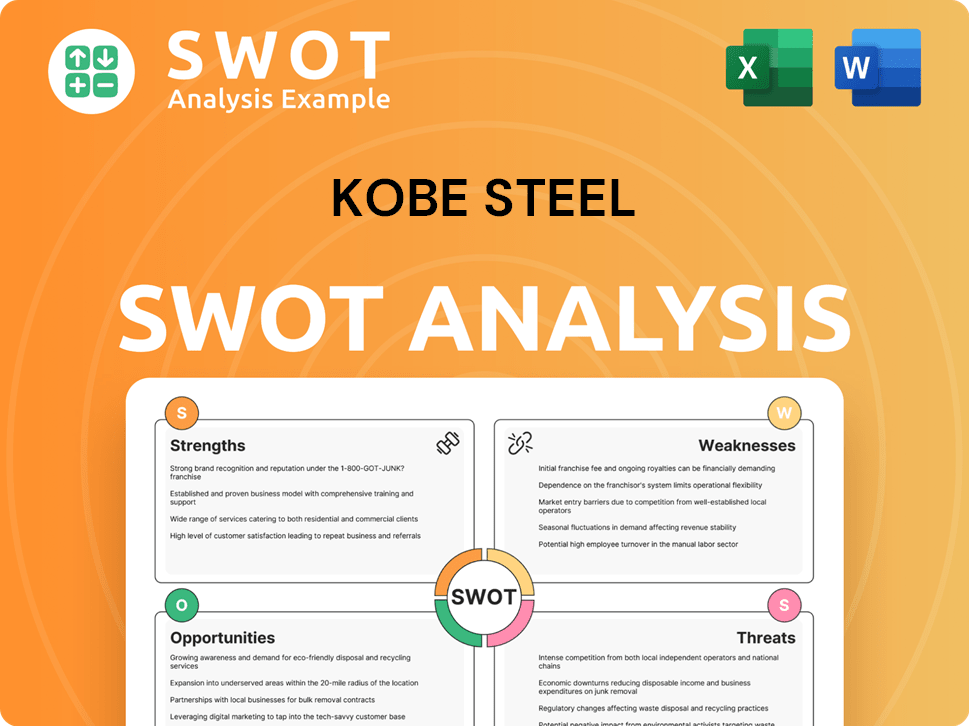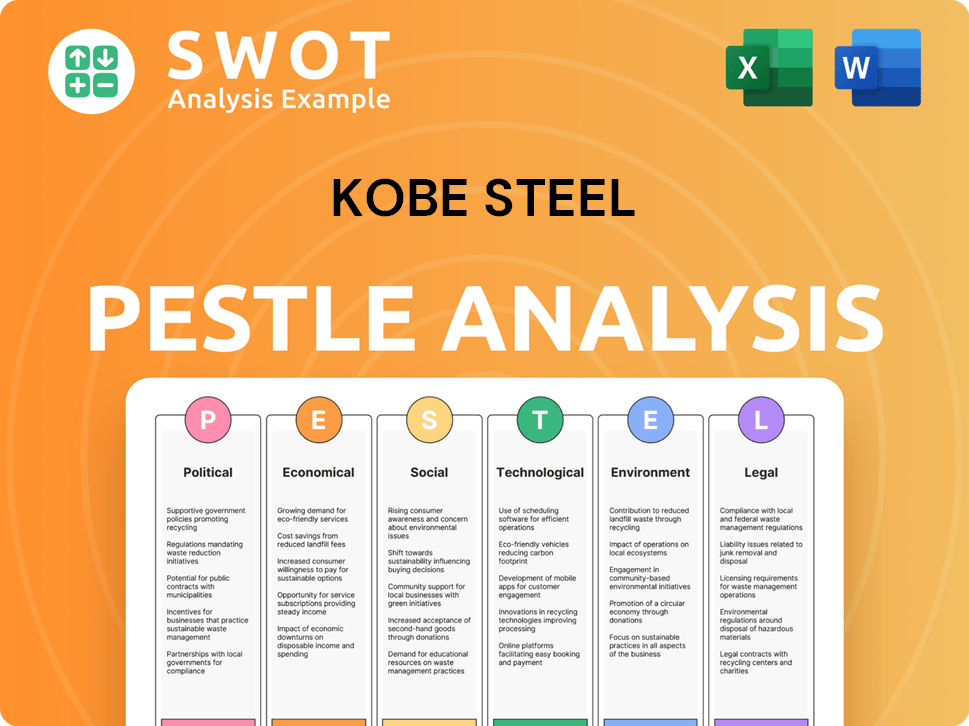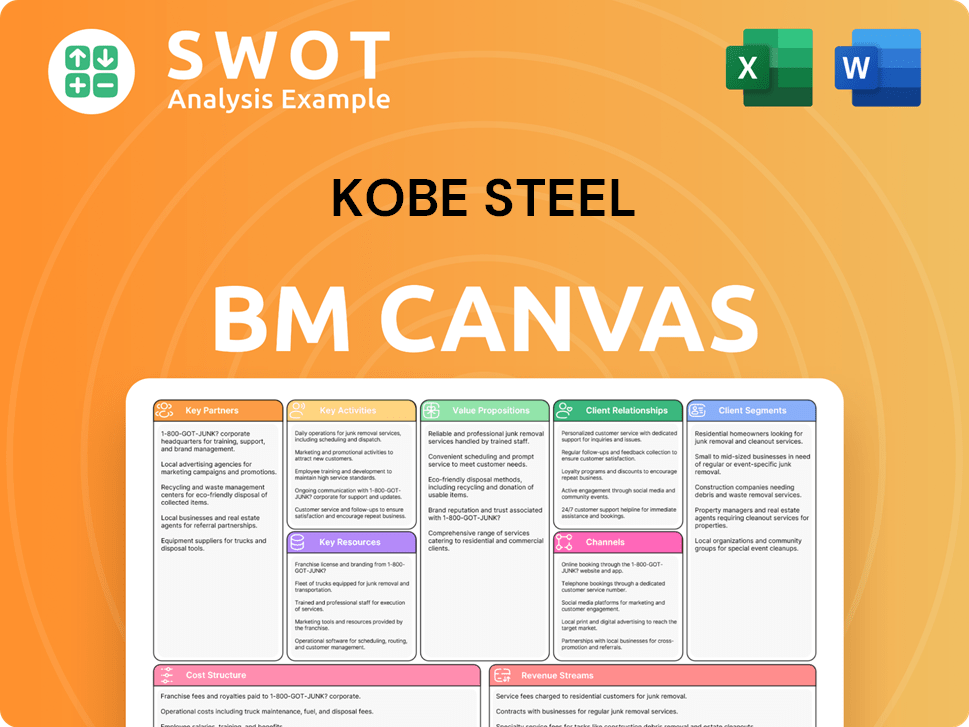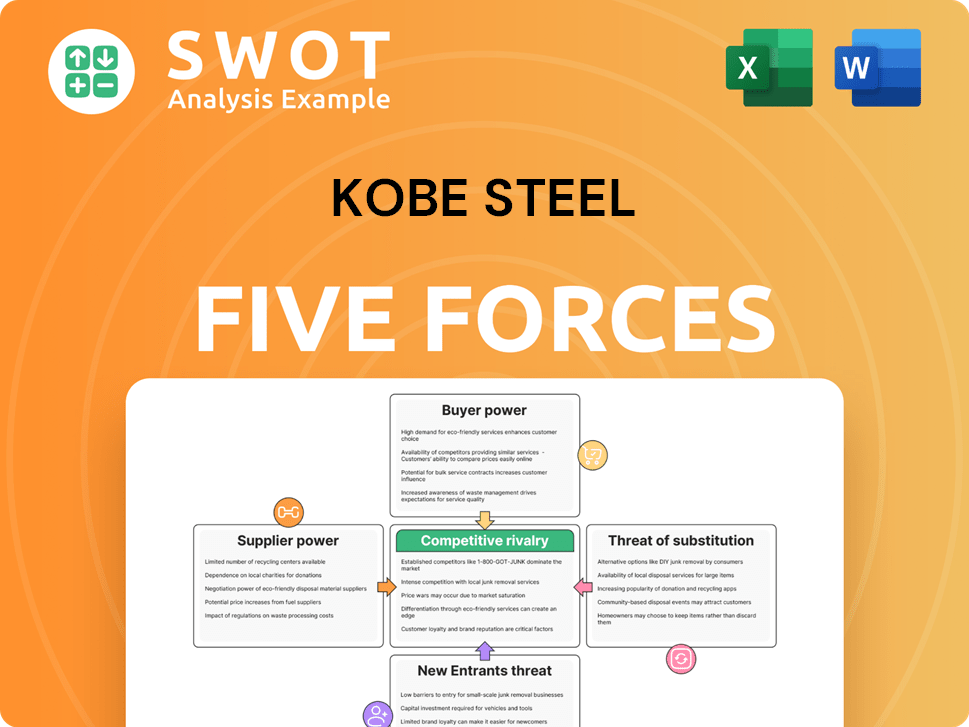Kobe Steel Bundle
Can Kobe Steel Maintain Its Competitive Edge?
Kobe Steel, a titan of Japanese industry since 1905, is facing a dynamic global market. From steel to machinery, its diverse portfolio is deeply integrated into worldwide industrial value chains. To understand its future, we must delve into the Kobe Steel SWOT Analysis and its competitive arena.

This comprehensive analysis of the Kobe Steel competitive landscape will dissect its market position, examining its primary rivals and strategic advantages. We'll explore Kobe Steel's financial performance, business strategy, and key strengths and weaknesses to provide a clear picture of its industry position. Understanding the competitive environment, including its global market presence and the impact of economic downturns, is crucial for investors and strategists alike.
Where Does Kobe Steel’ Stand in the Current Market?
Kobe Steel maintains a significant presence across various sectors, making its Kobe Steel competitive landscape complex. The company's core operations span steel, aluminum and copper products, industrial machinery, and engineering services. This diversification allows it to serve a wide range of industries, including automotive, construction, and electronics, contributing to a robust market position.
The company's value proposition lies in its ability to provide high-quality materials and solutions, supported by advanced technological capabilities and a focus on customer needs. Its strategic emphasis on higher-value-added products and solutions, particularly in specialized materials, strengthens its competitive edge. This approach is further enhanced by investments in digital transformation to improve operational efficiency and customer engagement.
The Kobe Steel market analysis shows a strong position in Japan, where it ranks among the top steelmakers. Globally, the company has a growing presence, especially in Asia, North America, and Europe, driven by the demand from the automotive and industrial sectors. The company's financial performance, as demonstrated by its net sales of ¥2,391.6 billion and operating income of ¥157.0 billion for the fiscal year ending March 31, 2024, highlights its financial health, although it is subject to global economic fluctuations.
Kobe Steel is a leading steel producer in Japan, consistently ranking among the top five in terms of crude steel production. While specific global market share data for 2024-2025 is dynamic, the company's position remains strong. The company's aluminum and copper businesses also hold significant shares, particularly in specialized products.
Kobe Steel has a substantial presence in Asia, especially in Japan and Southeast Asia. It is expanding its operations in North America and Europe to cater to the global automotive and industrial markets. This expansion supports its strategic goals to diversify its revenue streams and reduce reliance on any single market.
The company emphasizes higher-value-added products, focusing on premium markets and technological advancements. This strategic shift includes significant investments in digital transformation to improve operational efficiency. Kobe Steel's product portfolio includes steel sheets, plates, wire rods, and specialized materials for various industries.
For the fiscal year ended March 31, 2024, Kobe Steel reported net sales of ¥2,391.6 billion and operating income of ¥157.0 billion. This financial performance reflects its robust position, although it is subject to global economic cycles. The company's financial health is crucial for its continued investment in innovation and expansion.
Kobe Steel key strengths and weaknesses shape its competitive dynamics. Its technological expertise in specialized materials provides a significant competitive edge. However, the company faces challenges related to global economic fluctuations and raw material price volatility. Understanding these factors is crucial for assessing its future performance.
- Technological Innovation: Strong in specialized materials.
- Global Presence: Expanding operations worldwide.
- Financial Health: Demonstrated by recent financial results.
- Economic Sensitivity: Vulnerable to global economic cycles.
For a deeper understanding of the company's ownership and financial structure, you can refer to the insights provided by Owners & Shareholders of Kobe Steel. This information is essential for a comprehensive Kobe Steel industry position analysis.
Kobe Steel SWOT Analysis
- Complete SWOT Breakdown
- Fully Customizable
- Editable in Excel & Word
- Professional Formatting
- Investor-Ready Format

Who Are the Main Competitors Challenging Kobe Steel?
The Kobe Steel competitive landscape is shaped by a diverse set of rivals across its various business segments. Understanding these competitors is crucial for a thorough Kobe Steel market analysis and assessing its industry position. The company faces intense competition, requiring continuous adaptation and innovation to maintain its market share and profitability.
Kobe Steel's financial performance and business strategy are significantly influenced by the competitive environment. The company must navigate challenges from established players and emerging technologies. Strategic partnerships and technological advancements also play critical roles in shaping its future growth strategies.
In the steel sector, Kobe Steel's primary competitors include global giants. These rivals compete through scale, product diversification, and global distribution networks. For instance, Nippon Steel Corporation and JFE Holdings are major players in the Japanese market.
In the aluminum and copper segments, Kobe Steel faces competition from global metal producers. These companies compete on raw material access, processing technology, and specialized product development. Key competitors include Rio Tinto Alcan and Alcoa.
The industrial machinery and engineering divisions compete with global engineering firms and machinery manufacturers. These firms offer a wide range of industrial equipment and plant solutions. Competitors include Mitsubishi Heavy Industries and Siemens.
Indirect competition also arises from alternative materials and evolving technologies. The increasing use of carbon fiber and advanced plastics in the automotive industry presents a challenge to steel and aluminum demand. Emerging players in specialized materials and advanced manufacturing technologies could also disrupt traditional markets.
Mergers and alliances within the global steel industry reshape the competitive landscape. These consolidations create larger, more formidable rivals. The ongoing changes require Kobe Steel to continuously innovate and adapt to stay competitive.
Strategic partnerships are crucial for Kobe Steel to enhance its competitive position. Collaborations can provide access to new technologies, markets, and resources. These partnerships help in mitigating risk factors and challenges.
Kobe Steel's key strengths and weaknesses are critical in its competitive environment. The company's product portfolio analysis reveals its areas of focus and potential vulnerabilities. Understanding the competitive advantages is essential for strategic planning.
- Technological Advancements: Kobe Steel invests in technological advancements to improve its products and processes.
- Global Market Presence: The company has a global market presence, enabling it to reach customers worldwide.
- Sustainability Initiatives: Kobe Steel focuses on sustainability initiatives, which are increasingly important in the industry.
- Risk Factors and Challenges: The company faces various risk factors and challenges, including economic downturns and industry consolidation.
Kobe Steel PESTLE Analysis
- Covers All 6 PESTLE Categories
- No Research Needed – Save Hours of Work
- Built by Experts, Trusted by Consultants
- Instant Download, Ready to Use
- 100% Editable, Fully Customizable

What Gives Kobe Steel a Competitive Edge Over Its Rivals?
The Kobe Steel competitive landscape is shaped by its long-standing presence, diverse operations, and technological prowess. The company's strategic moves, including investments in advanced materials and engineering solutions, have positioned it to capitalize on evolving market demands. Understanding its competitive advantages is crucial for assessing its industry position and future prospects.
Kobe Steel's commitment to innovation and its integrated business model are key elements of its competitive edge. Its focus on high-performance steel, aluminum, and copper alloys, coupled with its expertise in welding consumables, provides distinct advantages. These strengths are essential for navigating the challenges and opportunities in the global market.
The company's financial performance and business strategy are intertwined with its ability to maintain and enhance its competitive advantages. Analyzing its market share analysis in 2024, along with comparisons to competitors like Nippon Steel, offers insights into its position and potential for growth. Recent acquisitions and mergers also play a role in shaping its competitive environment.
Kobe Steel's competitive advantages are significantly bolstered by its proprietary technologies and extensive intellectual property portfolio. The company holds key patents and trade secrets, particularly in high-performance steel, aluminum, and copper alloys. These advanced materials are critical for lightweighting in the automotive industry and high-strength applications in construction and infrastructure, meeting evolving environmental and safety standards. This technological edge is a primary factor in its industry position.
The integrated business model of Kobe Steel, spanning from material production to machinery and engineering, enhances its ability to offer comprehensive solutions to customers. This integration fosters synergies and cross-divisional collaboration, improving operational efficiency. The model also contributes to economies of scale in certain operations, allowing for competitive pricing and enhanced profitability. This integrated approach is a key element of its business strategy.
Kobe Steel benefits from strong brand equity, built over more than a century, fostering significant customer loyalty. This is particularly evident in Japan and among long-standing global clients who value its product quality and reliability. This brand recognition provides a competitive advantage in securing contracts and maintaining market share. The company's reputation supports its financial performance.
The company's robust research and development capabilities enable it to continuously innovate and adapt to changing market demands. This commitment to R&D helps sustain its advantages against imitation. Kobe Steel invests significantly in developing new materials and technologies, which is essential for maintaining its competitive edge. This ongoing investment is a key component of its future growth strategies.
Kobe Steel's key strengths include its technological innovation, integrated business model, and strong brand reputation. However, it faces challenges such as rapid technological advancements by competitors and global shifts in manufacturing paradigms. These factors influence its competitive environment.
- Strengths: Proprietary technologies, integrated business model, strong brand equity, and robust R&D.
- Weaknesses: Dependence on cyclical industries, potential impact of economic downturn, and vulnerability to technological disruptions.
- Opportunities: Growth in sustainable materials, expansion in emerging markets, and strategic partnerships.
- Threats: Intense competition, fluctuating raw material prices, and geopolitical risks.
Kobe Steel Business Model Canvas
- Complete 9-Block Business Model Canvas
- Effortlessly Communicate Your Business Strategy
- Investor-Ready BMC Format
- 100% Editable and Customizable
- Clear and Structured Layout

What Industry Trends Are Reshaping Kobe Steel’s Competitive Landscape?
The competitive landscape for Kobe Steel is shaped by a complex interplay of industry trends, challenges, and opportunities. A thorough Kobe Steel market analysis reveals the company's position within a dynamic global market, influenced by technological advancements, regulatory changes, and economic shifts. Understanding the Kobe Steel industry position is crucial for assessing its future prospects and strategic direction.
Kobe Steel's ability to navigate these factors will determine its success in the coming years. The company's business strategy must adapt to a changing environment. The company's financial performance is influenced by these factors. For a deeper dive into the company's origins, consider reading the Brief History of Kobe Steel.
Technological advancements, including AI and automation, drive innovation across all segments. The automotive and aerospace industries' demand for lightweight materials is increasing. Stricter environmental regulations and fuel efficiency targets are also factors. Global economic shifts and supply chain disruptions add further complexity to the market.
Fluctuating raw material prices and intense competition pose challenges. Significant capital investment is required for decarbonization technologies. The potential for new market entrants leveraging disruptive technologies is also a risk. The need for sustainable manufacturing practices is becoming increasingly important.
Emerging markets, particularly in Asia, offer significant growth potential. The increasing adoption of electric vehicles (EVs) creates new demand for specialized products. Expertise in advanced materials can lead to innovative solutions. Strategic partnerships and collaborations can enhance the company's market position.
Adapting to industry trends is crucial for long-term success. Investing in sustainable technologies is essential to meet environmental targets. Leveraging material science expertise can meet the evolving demands of the global industrial landscape. Collaboration and innovation are key drivers for future growth.
Kobe Steel's future hinges on its ability to adapt and innovate within a changing global landscape. The company must address challenges related to raw material costs and competition. Focusing on sustainable practices and technological advancements is vital for long-term growth. Strategic partnerships and investments in emerging markets will be key.
- Kobe Steel must invest in decarbonization technologies to meet environmental targets, with potential R&D and capital expenditures.
- The company should explore strategic partnerships to enhance its competitive position and facilitate market entry into new segments.
- Kobe Steel should capitalize on the growing demand for specialized materials in the EV sector and other emerging industries.
- The company should closely monitor and respond to global economic shifts and supply chain disruptions.
Kobe Steel Porter's Five Forces Analysis
- Covers All 5 Competitive Forces in Detail
- Structured for Consultants, Students, and Founders
- 100% Editable in Microsoft Word & Excel
- Instant Digital Download – Use Immediately
- Compatible with Mac & PC – Fully Unlocked

Related Blogs
- What are Mission Vision & Core Values of Kobe Steel Company?
- What is Growth Strategy and Future Prospects of Kobe Steel Company?
- How Does Kobe Steel Company Work?
- What is Sales and Marketing Strategy of Kobe Steel Company?
- What is Brief History of Kobe Steel Company?
- Who Owns Kobe Steel Company?
- What is Customer Demographics and Target Market of Kobe Steel Company?
Disclaimer
All information, articles, and product details provided on this website are for general informational and educational purposes only. We do not claim any ownership over, nor do we intend to infringe upon, any trademarks, copyrights, logos, brand names, or other intellectual property mentioned or depicted on this site. Such intellectual property remains the property of its respective owners, and any references here are made solely for identification or informational purposes, without implying any affiliation, endorsement, or partnership.
We make no representations or warranties, express or implied, regarding the accuracy, completeness, or suitability of any content or products presented. Nothing on this website should be construed as legal, tax, investment, financial, medical, or other professional advice. In addition, no part of this site—including articles or product references—constitutes a solicitation, recommendation, endorsement, advertisement, or offer to buy or sell any securities, franchises, or other financial instruments, particularly in jurisdictions where such activity would be unlawful.
All content is of a general nature and may not address the specific circumstances of any individual or entity. It is not a substitute for professional advice or services. Any actions you take based on the information provided here are strictly at your own risk. You accept full responsibility for any decisions or outcomes arising from your use of this website and agree to release us from any liability in connection with your use of, or reliance upon, the content or products found herein.